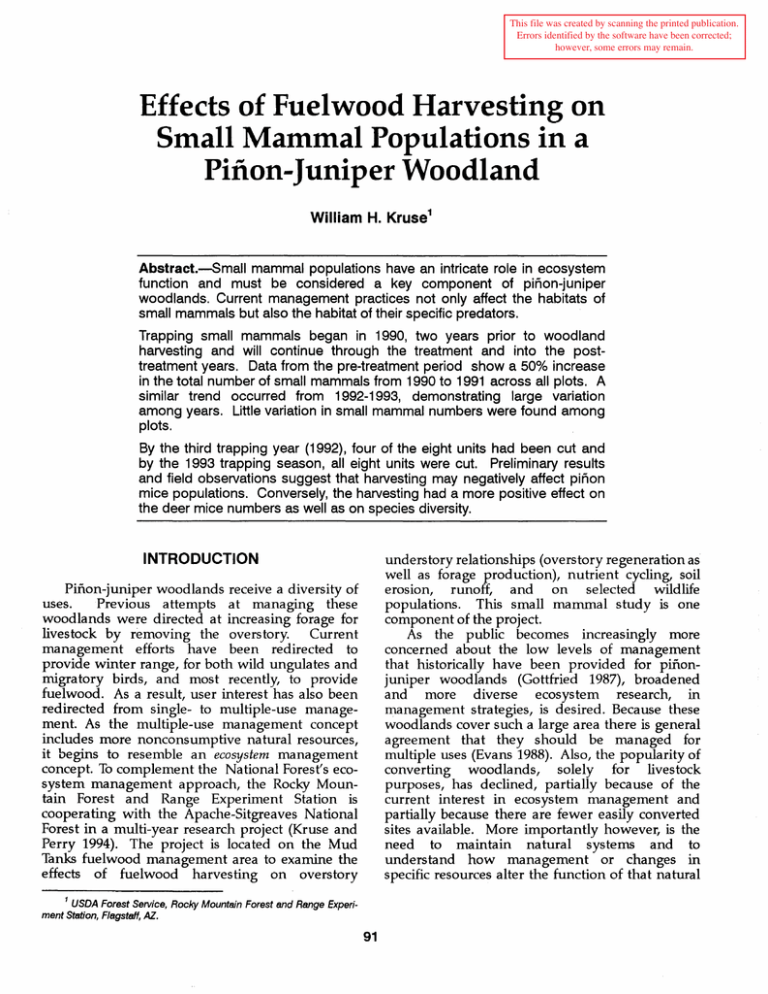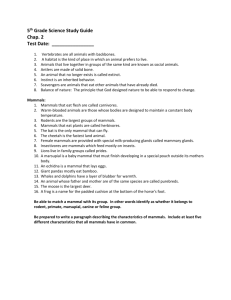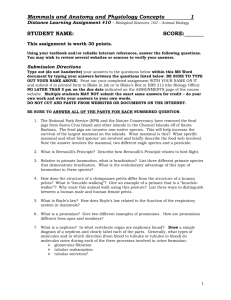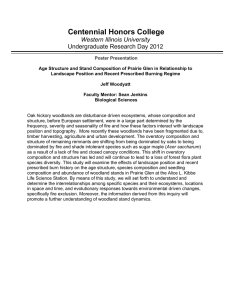Effects of Fuelwood Harvesting on Small Mammal Populations in a Pinon-Juniper Woodland
advertisement

This file was created by scanning the printed publication.
Errors identified by the software have been corrected;
however, some errors may remain.
Effects of Fuelwood Harvesting on
Small Mammal Populations in a
Pinon-Juniper Woodland
William H. Kruse1
Abstract.-Small mammal populations have an intricate role in ecosystem
function and must be considered a key component of pinon-juniper
woodlands. Current management practices not only affect the habitats of
small mammals but also the habitat of their specific predators.
Trapping small mammals began in 1990, two years prior to woodland
harvesting and will continue through the treatment and into the posttreatment years. Data from the pre-treatment period show a 50% increase
in the total number of small mammals from 1990 to 1991 across all plots. A
similar trend occurred from 1992-1993, demonstrating large variation
among years. Little variation in small mammal numbers were found among
plots.
By the third trapping year (1992), four of the eight units had been cut and
by the 1993 trapping season, all eight units were cut. Preliminary results
and field observations suggest that harvesting may negatively affect pinon
mice populations. Conversely, the harvesting had a more positive effect on
the deer mice numbers as well as on species diversity.
INTRODUCTION
understory relationships (overstory regeneration as
well as forage production), nutrient cycling, soil
erosion, runoff, and on selected wildlife
populations. This small mammal study is one
component of the project.
As the public becomes increasingly more
concerned about the low levels of management
that historically have been provided for piftonjuniper woodlands (Gottfried 1987), broadened
and more diverse ecosystem research, in
management strategies, is desired. Because these
woodlands cover such a large area there is general
agreement that they should be managed for
multiple uses (Evans 1988). Also, the popularity of
converting woodlands, solely for livestock
purposes, has declined, partially because of the
current interest in ecosystem management and
partially because there are fewer easily converted
sites available. More importantly however, is the
need to maintain natural systems and to
understand how management or changes in
specific resources alter the function of that natural
Pifton-juniper woodlands receive a diversity of
uses.
Previous attempts at managing these
woodlands were directed at increasing forage for
lives tock by removing the overs tory.
Current
management efforts have been redirected to
provide winter range, for both wild ungulates and
migratory birds, and most recently, to provide
fuelwood. As a result, user interest has also been
redirected from single- to multiple-use management. As the multiple-use management concept
includes more nonconsumptive natural resources,
it begins to resemble an ecosystem management
concept. To complement the National Forest's ecosystem management approach, the Rocky Mountain Forest and Range Experiment Station is
cooperating with the Apache-Sitgreaves National
Forest in a multi-year research project (Kruse and
Perry 1994). The project is located on the Mud
Tanks fuelwood management area to examine the
effects of fuelwood harvesting on overstory
1 USDA Forest Service, Rocky Mountain Forest and Range Experiment Station, Flagstaff, AZ.
91
m 3jha of fuelwood. Sixty-three percent of the trees
are piii.on. One-seed juniper is the second most
common species followed by alligator juniper.
Ponderosa pine (Pinus ponderosa) occasionally
occurs on moist sites. Average canopy cover is 40%
(Laing et al. 1988). Average annual herbaceous and
wood y plant potential productivity is about 562
kglha.
The area is relatively flat, dissected by several
Elevations are
small ephemeral drainages.
between 2,000 and 2,060 m. The primary soil
subgroups, derived from limestone, are Lithic
Ustochrepts, Udic Haplustalfs, and Typic
Eutroboralfs. The mean annual precipitation varies
between 34 and 46 cm.
The overall research project consists of 33 units,
4-ha in size. Thirty 4-ha study units were grouped
into 5 blocks each with 6 overstory treatments.
Sixteen of these were selected for the small
mammal study. These sixteen contained all the
overstory conditions represented in the overall
research project.
The experimental design entails a randomized
block layout. Blocks were designated based on
similarity of pre-treatment overstory conditions
and characteristics. The experimental units entail
combinations of burning, no-burning, and cutting,
no-cutting.
Hence, the small mammal study
repeats these four treatments in each of four blocks.
Treatments were assigned randomly to each block
and were located as conditions permit and
therefore were not necessarily contiguous; roads or
drainage channels could separate units within a
given block Nevertheless, all treatments for each
block are in the same area. Harvesting began in
the falVwinter of 1991 and continued up to 24
months. Burning will commence on those units
when the slash approaches 2 years old.
A 100m X 100m trapping grid was located in the
center of each block utilizing about 85% of it. At
each grid point, 10m x 10m apart, was placed an 8
X 10 X 25cm Sherman live trap. At every other
point, a 10 X 12 X 40cm Sherman live trap was
located with the smaller one. The bait was a
mixture of chicken scratch and rolled oats. Thus
each unit was sampled yearly with 150 traps for 3
nights and 2 days. Demographic and physical
measurements were taken and recorded on each
animal caught. Each animal was toe clipped and
released. Recaptures were noted.
Relative abundance and species composition
(Table 1) of small mammals was estimated by livetrapping on four overstory treatments: (1) type
conversion (where the fuelwood has been
harvested, residual trees cut and the slash burned);
system (Gottfried 1987).
Finally, the recent
emphasis on fuelwood harvesting and slash
disposal has added a new dimension to managing
these woodlands particularly in the context of
managing natural systems (Ffolliott et al. 1979).
FUELWOOD HARVESTING AND THE SMALL
MAMMAL COMMUNITY
The increase of fuelwood harvesting has
prompted increased concern for assessing the
effect of both fuel wood removal and slash disposal,
particularly burning, on nutrient cycling,
understory production (specifically forages for
livestock and other large ungulates), and small
mammals in these pinon-juniper woodlands. In
Arizona, fuelwood demands increased over 400%
between 1973 and 1978 (Ffolliott et al. 1979). Land
managers are currently attempting to develop
sound silvicultural prescriptions for these
woodlands, but basic ecological information
needed to support current harvesting plans is often
lacking (Gottfried 1987). Fuelwood harvest is the
most significant factor affecting the overstory
while the least understood management option has
been slash deposition (Severson 1986; Baker and
Frischknecht 1972).
Because previous research has shown that
species' populations can be impacted by overstory
disturbances (Turkowski and Reynolds 1970), this
study will provide quantitative information on
small mammals following fuelwood harvest. For
example, Severson (1986),. in New Mexico, found
that total rodent numbers were significantly
greater on treated compared to untreated
woodlands. Kruse et al. (1979) found that treated
areas differed from the woodland in that those
rodent species which preferred the woodland
condition, decreased in numbers on the treated
areas. Whether trends such as these will follow
fuelwood harvesting is the focus of this research.
Finally, and because small mammals have an
intricate role in the food chain as prey for raptors
and carnivores, information determined from this
study will provide information for those predators
as well.
STUDY AREA AND METHODS
The study is being conducted on the Heber
Ranger District, Apache-Sitgreaves National Forest,
in central Arizona. Average tree conditions are 23.2
+ 5.4 m 2jha of basal area, producing 35.3 + 12.7
92
(2) cut but not burned (where the fuelwood has
been harvested but the non-commercial trees are
not cut nor is the slash burned); (3) no cut but
burned (analogous to a forest fire where the
overs tory is removed by fire; some fire ladders
were cut to facilitate the burning); and (4) the
controls (where the units remain untreated) (see
Table 2). Small mammal trapping is being
conducted once each year Guly-August).
The null hypotheses, that there are no
differences in (1) total number of small mammals or
(2) total number of species among treatments, will
be tested utilizing years as repeated measures.
TOTAL CAPTURES
Small Mammals 1990-1993
~
~ 120
'c 100
::::>
~ 80
a
cv
c:
~ 20
:E
NOTR
NOTR
NOTR
NOTR
NOTR
NOTR
NOTR
NOTR
NOTR
NOTR
NOTR
NOTR
NCB1 NCB2 NCB3 NCB4
NCB1 NCB2 NCB3 NCB4
NCB1 NCB2 NCB3 NCB4
NCB1 NCB2 NCBS NCB4
15-2
14-4
16-4
21-4
III
IV
I
V
NOTR
NOTR
NOTR
NOTR
NOTR
NOTR
NOTR
NOTR
NOTR
CNB1
CNB1
NOTR
CNB1
CNB2
CNB2
CNB1
CNB2
CNB3
CNB3
CNB2
14-2 III
15-1 IV
16-3 I
21-1 V
NOTR
CNB1
CNB3
CNB4
CNB4
CNB3
CNB4
CNB5
CNB5
CNB4
1990
1991
1992
1993
1990
1991
43.5
+/- 6
86.4
1992
39.1
1993
124.9
+/- 8
+/- 8
+/- 18
Figure 1.-Hlghly significant annual variation.
PRELIMINARY RESULTS
Table 3 shows mean captures for the uncut and
cut units for the four years of sampling. These data
demonstrate the dominance of the two Peromyscus
species relative to the total numbers of all captured
animals.
Populations fluctuated during the first four
years of the study. These first analyses show
significant differences between years,(p < 0.001).
Figure 1 best expresses this yearly variation, as well
as the significant interaction between treatment
and year factors.
Figure 2 demonstrates an analyses on all small
mammal captures and shows the similarity
between cut and uncut study units prior to harvest.
There were no differences among units prior to
treatment (Fig. 2). A significant doubling of total
population numbers from 1990 to 1991 is evident.
Figures 4 and 6 show again the similarity
among pre-treatment study units as well as the
similarity within each species' population. An
increase in the number of captures was similar for
both the pmon mouse and deer mouse between
1990 and 1991. More .notable, however, was that of
the highly significant (p < 0.001) increase in 1991
over 1990 of the deer mouse which contributed the
greater portion was contributed of all small
mammal captures.
Table 2.-Treatment schedule for small mammal study units.
UNIT
BlKS
1990 1991 1992
1993 1994 1995
1996 1997
10-4 III NOTR NOTR NOTR NOTR NOTR NOTR NOTR NOTR
11-4 IV NOTR NOTR NOTR NOTR NOTR NOTR NOTR NOTR
15-4 I NOTR NOTR NOTR NOTR NOTR NOTR NOTR NOTR
20-2 V NOTR NOTR NOTR NOTR NOTR NOTR NOTR NOTR
NOTR
NOTR
NOTR
NOTR
o
Year:
Mean:
Table 1.-Small mammal species list from Mud Tanks.
deer mouse
38%
pirion mouse
48%
brush mouse
5%
white throated wood rat
2%
Mexican wood rat
2%
cliff chipmunk
4%
Ord's kangaroo rat
<1%
meadow vole
< 1%
rock squirrel
< 1%
III
IV
I
V
60
u 40
Peromyscus maniculatus
P. truei
P. boyJii
Neotoma a/bigula
N. mexicanus
Eutamias dorsa/is
Dipodomys ordii
Microtus pennsylvanicus
Spermophilus variegatus
14-1
15-3
20-4
21-2
140~----------------------~
CNB5
CNB6
CNB6
CNB5
NOTR NOTR CNB1 CNB2 C&B1 C&B2 C&B3 C&B4
NOTR NOTR NOTR CNB1 CNB2 C&B1 C&B2 C&B3
NOTR NOTR CNB1 CNB2 C&B1 C&B2 ,C&B3 C&B4
NOTR NOTR NOTR CNB1 CNB2 C&B1 C&B2 C&B3
= No Treatment; NCB1 = No Cut, Burned (year);
= Cut/Not Burned, (year); C&B1 = Cut & Burned, (year)
Table 3.-Mean captures for uncut and cut treatments by year.
1990
1991
1992
1993
UCC
UC C
UC
C
UC
C
P. maniculatus
3.8 4.1 18.4 16.6 2.9 7.5
11.8 45.6
P. truei
16.3 12.8 20.1 19.4 12.5 10.4
30.5
20.0
All others
5.6
10.7
3.7
3.0 ~ ~ 5.5 U
Total animals
23.1 20.4 44.6 41.5 17.5 21.6
47.9 76.3
93
Small Mammal Captures
Deer Mouse Captures
before harvest (1990-1991 )
~
'c
50
before harvest (1990-1991)
---------------------------,
~
'c::J
::J
~ 40-
20
,-----'--------'----'-~-------------.
~ 15
Q)
~30
Q)
:;
~
15.
20
('0
15.
('0
~ 10
(J
ffi
10
~
0
~ 5
('0
Q)
Q)
~
UNCUT
0
UNCUT
CUT~o b~
[ili-OT9OoT0TM)
CUT (to be)
['. PEMA90 0 PEMA9}J
Figure 4.-Deer mouse contributions to the annual yearly variation
In total captures prior to harvest.
Figure 2.-Annual yearly variation in small mammal captures prior
to harvest.
Small Mammal Captures
Deer Mouse Captures
before( 1991) and after( 1993) harvest
before(1991) and after(1993) harvest
~80 ~-----------------~
~50,-------------------.
'c
'c
~Q) 60
~ 40
<"'
~30
Q)
:;
::J
::J
Q)
~ 40
15.
('0
15.
20
('0
~ 20
(J
ffi
('0
Q)
~
10
Q)
~ 0
0
UNCUT
CUT
[. TOT91 b3 TOT93 1
UNCUT
CUT
[iiPEMA91 E3J PEMA931
Figure 3.-Harvest effect on small mammal captures comparing
units prior to and after harvest.
Figure S.-Harvest effects on deer mouse captures comparing
units prior to and after harvest.
During 1992 and 1993, 8 of the 16 study units
were harvested for fuelwood. The slash was
lopped and scattered over the cut units and by July
1993 was in various stages of aging. The trapping
data from 1992 contained effects of some of the
treated units and by trapping time in 1993, all "tobe" harvested units were cut. Data from 1993
reflects a cut treatment vs. an uncut treatment
comparison.
Figure 3, the "Small Mammal Capture" graph
for before (1991) versus after (1993) treatment,
shows significant interaction between time and
treatment (p < 0.001), indicating an increase on the
harvested areas. This shows total captures on
harvested areas was 84% higher than on uncut
areas.
The "Deer Mouse Capture" graph (Fig. 5)
displays a 174% increase in deer mouse captures on
the harvested areas over the unharvested
(time/treatment interaction significant at p <0.001).
This large increase in deer mice suggests that
fuelwood harvesting and the subsequent slash has
a positive affect on deer mouse populations.
Conversely, the "Pifton Mouse Capture" graph
(Fig. 7) shows "no or little change" in pifton mice
(time/treatment
populations following harvest
interaction would be significant at p = .051). Given
the positive effects of "treatment" on small
mammal populations, and the fact that the piflon
mouse numbers did not change, suggests harvest
of pifton-juniper trees to have a negative effect on
the pifton mouse population numbers.
94
Pinyon Mouse Captures
Pinyon Mouse Captures
before( 1991 ) and after( 1993) harvest
before harvest (1990-1991)
_ 35
~25~-------------------------------~
'c
c:
.g 30
:::l
15 20
~15
m25
Q)
~
~ 20
:;
%15
0.10
to
~ 10
m5
~ 0
u
~
c:
5
Q)
~
0
UNCUT
CUT (to be)
UNCUT
CUT
I_ PETR91 EJ PETR93I
I_ PETR90 [] PETR91 I
Figure 6.-Plnon mouse contributions to the annual yearly
variation In total captures prior to harvest.
Figure 7.-Harvest effects on pinon mouse captures comparing
units prior to and after harvest.
DISCUSSION
showed that slash can be manipulated to affect
small mammal populations but that an overstory of
pifton-juniper was important to the pinon mouse.
For our data at the Mud Tanks Study, the slash has
yet to be burned. Therefore, if slash is an important
factor in affecting population densities of small
mammals, then slash has been in effect. After the
slash is burned, we eventually will separate slash
effects from the effects of overstory treatment.
Slash is usually left where it falls. Juniper slash,
unlike pine slash, is resistant to decomposition and
will influence the site for a longer period of time.
Some theorize that this residual slash protects both
tree and forage species from severe microclimatic
stresses and from early herbivory by large
ungulates. Residual slash, while providing an
improved site for plant regeneration and
development, may provide an improved habitat for
Baker and
small mammal populations.
Frischknecht (1973) found no effect from slash on
mice populations, except wJ:lere it was windrowed.
Severson (1986) suggested, however, that
treabnents leaving slash benefited woodrats and
brush mice following canopy removal. He also
found that overstory was more important to the
pifton mouse than the slash component.
The interaction of herbivores within the piftonjuniper woodland has been documented with
respect to birds, small mammals, insects, and the
competition between these consumers and the
forage resources (Christensen and Whitham 1993).
An earlier study suggested that because three
species of birds and three species of mammals use
pifton seeds for food, herbivory directly affected
their resource base _and the interactions among
them.
Therefore, severe overstory treabnent
resulting in heavy slash accumulation not only
affected the seed/forage base but altered ground
habitat requirements for those seed eating species.
An understanding of treabnent effects on
species is necessary for anticipating the interaction
of other herbivores in the system. Severson (1986)
SUMMARY
Information gained from this study will
provide a basis for developing improved guidelines
for a more intensive focus of ecosystem
management in the southwestern United States.
Population densities of small mammals can relate
to site productivity and quality much the same as
forage plant species are used. And finally with
regards to this study, the value of this small
mammal research is magnified since it is part of an
unprecedented endeavor to simultaneously study
the integrated effect of nutrient cycling, other
wildlife, and wood product management strategies
on the soil, water, tree, and range resources in
pifton-juniper woodlands (Kruse and Perry 1994).
LITERATURE CITED
Baker, Maurice E and Neil C. Frischknecht. 1973. Small
mammals increase on recently cleared and seeded
juniper rangeland. J. Range Manage. 26:101-103.
95
Kruse, W. H., R. P. Balda, M. J. Simono, A. M. Macrander,
and C. D. Johnson. 1979. Community development in
two adjacent pinyon-juniper eradication areas
twenty-five years after treatment. J. Environ.
Manage. 8: 237-247.
Laing, Larry; Ambos, Norman; Subirge, Tom; McDonald,
Christine; Nelson, Chris; Robbie, Wayne. 1988.
Terrestrial ecosystems survey of the ApacheSitgreaves National Forest. Albuquerque, NM: U.S.
Department of Agriculture, Forest Service,
Southwestern Region. 453 p.
Severson, K. E. 1986. Small mammals in modified
pinyon-juniper woodlands, New Mexico. Journal of
Range Management. 39: 31-34.
Springfield, H. W. 1976. Characteristics and management
of southwestern pinyon-juniper ranges: the status of
our knowledge. Res. Pap. RM-160. Fort Collins, CO:
U.S. Department of Agriculture, Forest Service, Rocky
Mountain Forest and Range Experiment Station. 32 p.
Turkowski, R J. and H. G. Reynolds. 1970. Response of
some rodent populations to pinyon-juniper
reductions on the Kiabab Plateau, Arizona.
Southwest. Natur. 15:23-27.
Christensen, K. M., T. G. Whitham. 1991. Indirect
herbivore mediation of avian seed dispersal in
pinyon pine. Ecology 72:534-542.
Christensen, K. M., T. G. Whitham. 1993. Impact of insect
herbivores on competition between birds and
mammals for pinyon pine seeds. Ecology 74(8):22702278.
Evans, Raymond A. 1988. Management of pinyonjuniper woodlands. Gen. Tech. Rep. INT-249. Ogden,
UT: U.S. Department of Agriculture, Forest Service,
Intermountain Research Station. 34 p.
Ffolliott, Peter R; Rasmussen, William 0.; Warfield,
Thomas K.; Botland, David S. 1979. Supply, demand,
and economics of fuelwood markets in selected
population centers of Arizona. Arizona Land Marks
9(2). Phoenix, AZ: Arizona State Land Department.
14p.
Gottfried, Gerald J. 1987. Regeneration of pinyon. In:
Proceedings-pifton-juniper
conference;
1986
January 13-16; Reno, NY. Ogden, UT: U.S.
Department of Agriculture, Forest Service,
Intermountain Research Station: 249-254.
Kruse, W. H., H. M. Perry, 1984. Ecosystem management
and fuelwood harvesting in an "old growth" piftonjuniper woodland. (This symposium)
96





